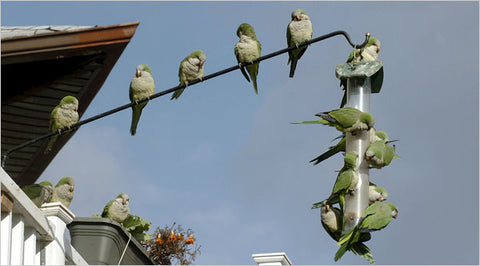Photo Credit: Parrots in the Snow By Seboh
Imagine looking up in the New York City sky and seeing a flock of medium sized green and white parrots above. Yes, indeed. Brooklyn, the Bronx and Queens are home to a large group of feral Quaker Parrots. Known as "the wild parrots of Brooklyn," no one really knows how these Argentinian natives arrived so far North, but they've been in the Big Apple since the early '70's. Did they escape from smugglers or criminals at the airport? That's the legend.
Most of us associate wild parrots with sub-tropical climates such as Northern South America and Central America. There are even several species of parrots in Africa and the Asia Pacific. But New York?
Fact is, Quaker Parrots, also know as the Monk Parakeet is incredibly robust. There are feral flocks of these stout little birds in Chicago and Montreal, too. So, how is it that a feral parrot can survive harsh winters of the Northern US and Canada?
About Quaker Parrots

- Photo Credit: Alan Zale for The New York Times Brooklyn Parrots Feeding
Quaker parrots are unusual, as far as parrots go. Sure there are several species of parrots that live in huge flocks. Huddling up with hundreds of flock-mates can help keep a bird warm. But, most of these species, while in a huge flock, pair off with one special mate in their own nest cavity. Quakers too are known to live in massive flocks however, one reason they can tolerate harsh winters outdoors is because of their curious nesting behavior. You see, Quaker Parrots build gigantic nests out of sticks high above the ground. Sticks, twigs, grasses and other insulating natural products are woven together into huge structures. These intricate nests are like a mini-condo with 3 chambers. The inner sanctum is for new hatchlings. It is surrounded by a corridor where fledglings flock awaiting their passage to a new life. It's quite sophisticated, really. Adult birds guard the babies like, err ... a hawk. They are also constantly refurbishing and revamping the nest to accommodate such a huge flock.
 Quaker parrot flockss have a definitive police system to keep what would normally be predators in check. One or more flock members act as a "watchman" or "guard" blaring a warning call whenever a predator is spotted. The parrots work together to drive the unwelcome birds of prey or "egg stealers: off. Since crows try to steal eggs, they are unwelcome. But, that said, Quakers are quite welcoming of safe urban birds, such as pigeons, sparrows, and doves. Single kept quaker parrots often miss the comfort and security of flock mates and quakers are known to be prone to feather plucking, as a result.
Quaker parrot flockss have a definitive police system to keep what would normally be predators in check. One or more flock members act as a "watchman" or "guard" blaring a warning call whenever a predator is spotted. The parrots work together to drive the unwelcome birds of prey or "egg stealers: off. Since crows try to steal eggs, they are unwelcome. But, that said, Quakers are quite welcoming of safe urban birds, such as pigeons, sparrows, and doves. Single kept quaker parrots often miss the comfort and security of flock mates and quakers are known to be prone to feather plucking, as a result.
So, while most captive parrots need a little help coping with cold winter months, the Quaker Parrot has it figured out by living in huge flocks, working as a team to insure safety and a unique nest.
Have you had a chance to see the Brooklyn Quakers? Tell us about it!
Hey, please leave a comment or share this on your social media if you love this post!
















